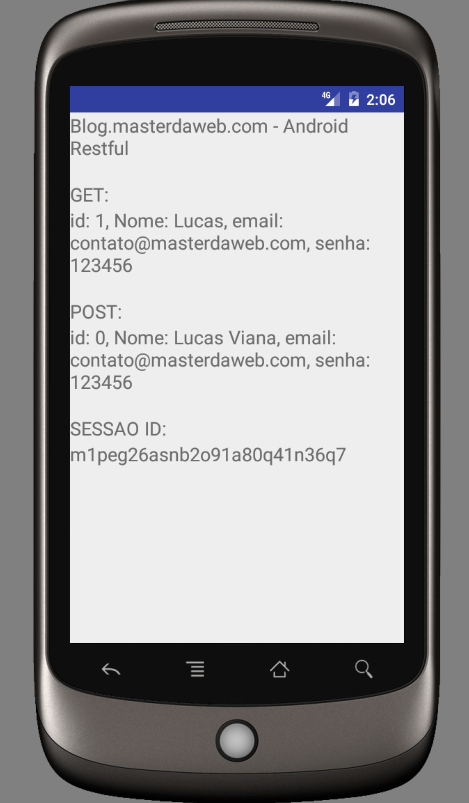Android Annotations Restful Tutorial (PHP Webservice)

En este tutorial te enseñaré cómo construir un servicio Restful en Android usando Android Annotations v4.2. Utilizaré un servidor PHP como ejemplo.

Bibliotecas utilizadas:
- Anotaciones Android v4.2
- Spring Framework v2.0.0.M3 (versión Android)
- Jackson Databind v2.8.5
Si desea profundizar en los recursos descritos en este tutorial, le recomiendo que acceda a la siguiente documentación:
- https://github.com/androidannotations/androidannotations/wiki/Rest-API
- https://github.com/FasterXML/jackson-annotations
Para descargar el proyecto completo: RestApplication
El Webservice en PHP:
<?php
/**
* http://blog.masterdaweb.com
* User: Lucas
* Date: 17/12/2016
* Time: 14:22
*/
ini_set("log_errors", 1);
ini_set("error_log", "php-error.log");
$data = json_decode(file_get_contents("php://input"));
switch ($_GET['acao']) {
case 'buscar':
header('Content-Type: application/json');
$output = json_encode(
array(
'id' => $_GET['id'],
'nome' => 'Lucas',
'email' => 'contato@masterdaweb.com',
'senha' => '123456'
)
);
break;
case 'cadastrar':
header('Content-Type: application/json');
$output = json_encode(
array(
'nome' => $data->nome,
'email' => $data->email,
'senha' => $data->senha
)
);
break;
case 'pagina-protegida':
header('Content-Type: text/html');
session_start();
$output = session_id();
break;
}
echo $output;
Ahora la aplicación para Android
apply plugin: 'com.android.application'
buildscript {
repositories {
jcenter()
}
dependencies {
classpath 'com.android.tools.build:gradle:2.2.3'
classpath 'com.neenbedankt.gradle.plugins:android-apt:1.8'
// NOTE: Do not place your application dependencies here; they belong
// in the individual module build.gradle files
}
}
allprojects {
repositories {
jcenter()
}
}
android {
compileSdkVersion 25
buildToolsVersion "25.0.1"
defaultConfig {
applicationId "com.example.lucas.restapplication"
minSdkVersion 15
targetSdkVersion 25
versionCode 1
versionName "1.0"
}
buildTypes {
release {
minifyEnabled false
proguardFiles getDefaultProguardFile('proguard-android.txt'), 'proguard-rules.pro'
}
}
packagingOptions {
exclude 'META-INF/spring.tooling'
exclude 'META-INF/spring.handlers'
exclude 'META-INF/spring.schemas'
exclude 'META-INF/LICENSE'
}
}
apply plugin: 'com.android.application'
apply plugin: 'android-apt'
def AAVersion = '4.2.0'
dependencies {
compile fileTree(include: ['*.jar'], dir: 'libs')
compile 'com.android.support:appcompat-v7:25.0.1'
apt "org.androidannotations:androidannotations:$AAVersion"
compile "org.androidannotations:androidannotations-api:$AAVersion"
apt "org.androidannotations:rest-spring:$AAVersion"
compile "org.androidannotations:rest-spring-api:$AAVersion"
compile "org.springframework.android:spring-android-rest-template:2.0.0.M3"
compile 'com.fasterxml.jackson.core:jackson-databind:2.8.5'
}
La clase User descrita a continuación es nuestro Modelo, se enlazará con el webservice, esto es posible gracias a Jackson Bind:
@JsonIgnoreProperties(ignoreUnknown = true)
public class Usuario implements Serializable {
@JsonProperty("id")
private int id;
@JsonProperty("nome")
private String nome;
@JsonProperty("email")
private String email;
@JsonProperty("senha")
private String senha;
public Usuario(String nome, String email, String senha) {
this.nome = nome;
this.email = email;
this.senha = senha;
}
public Usuario() {
}
public int getId() {
return id;
}
public String getNome() {
return nome;
}
public String getEmail() {
return email;
}
public String getSenha() {
return senha;
}
@Override
public String toString(){
return "id: " + getId() + ", Nome: " + getNome() + ", email: " + getEmail() + ", senha: " + getSenha();
}
}
Ahora definiremos nuestra clase Rest:
@Rest(rootUrl = "http://10.0.2.2", converters = {MappingJackson2HttpMessageConverter.class, StringHttpMessageConverter.class, FormHttpMessageConverter.class})
public interface MyRestClient {
//Busca o recurso 'usuario' pelo id
@Get("/rest.php?acao=buscar&id={id}")
Usuario getUsuarioById(@Path int id);
//Cadastra o recurso 'usuario'
@Post("/rest.php?acao=cadastrar")
Usuario postUsuario(@Body Usuario usuario);
//Acessa página protegida usando ID da sessão PHP
@Get("/rest.php?acao=pagina-protegida")
@RequiresCookie("PHPSESSID")
String paginaProtegida();
void setHeader(String name, String value);
String getHeader(String name);
void setCookie(String name, String value);
String getCookie(String name);
}
La IP 10.0.2.2 debe sustituirse por la dirección de su Webservice. Si estás usando un servidor localhost, mantén esta IP para que el emulador pueda acceder a localhost, porque si pones «localhost» en lugar de esta IP, el emulador no reconocerá tu entorno localhost.
@EActivity(R.layout.activity_main)
public class MainActivity extends Activity {
@RestService
MyRestClient rest;
@ViewById
TextView getResponse, postResponse, sessaoResponse;
Usuario getUsuario;
Usuario postUsuario;
String sessaoId;
@AfterViews
void load() {
runRest();
}
@Background
void runRest() {
getUsuario = rest.getUsuarioById(1);
postUsuario = rest.postUsuario(new Usuario("Lucas Viana", "contato@masterdaweb.com", "123456"));
rest.setCookie("PHPSESSID", "m1peg26asnb2o91a80q41n36q7");
sessaoId = rest.paginaProtegida();
setData();
}
@UiThread
void setData(){
getResponse.setText(getUsuario.toString());
postResponse.setText(postUsuario.toString());
sessaoResponse.setText(sessaoId);
}
}
Y, por último, nuestro punto de vista:
<?xml version="1.0" encoding="utf-8"?>
<LinearLayout xmlns:android="http://schemas.android.com/apk/res/android"
xmlns:tools="http://schemas.android.com/tools"
android:id="@+id/activity_main"
android:layout_width="match_parent"
android:layout_height="match_parent"
android:orientation="vertical">
<TextView
android:layout_width="wrap_content"
android:layout_height="wrap_content"
android:textSize="18dp"
android:layout_marginBottom="20dp"
android:text="Blog.masterdaweb.com - Android Restful" />
<TextView
android:layout_width="wrap_content"
android:layout_height="wrap_content"
android:textSize="18dp"
android:text="GET:" />
<TextView
android:id="@+id/getResponse"
android:layout_width="wrap_content"
android:layout_height="wrap_content"
android:layout_marginBottom="20dp"
android:textSize="18dp" />
<TextView
android:layout_width="wrap_content"
android:layout_height="wrap_content"
android:textSize="18dp"
android:text="POST:" />
<TextView
android:id="@+id/postResponse"
android:layout_width="wrap_content"
android:layout_height="wrap_content"
android:layout_marginBottom="20dp"
android:textSize="18dp" />
<TextView
android:layout_width="wrap_content"
android:layout_height="wrap_content"
android:textSize="18dp"
android:text="SESSAO ID:" />
<TextView
android:id="@+id/sessaoResponse"
android:layout_width="wrap_content"
android:layout_height="wrap_content"
android:textSize="18dp" />
</LinearLayout>